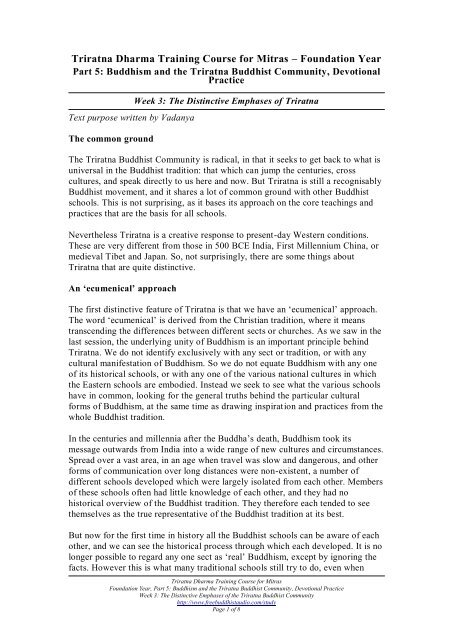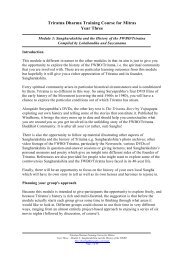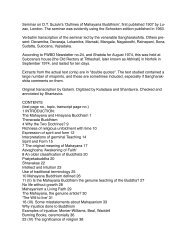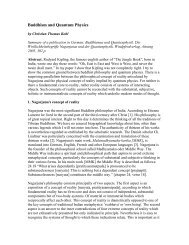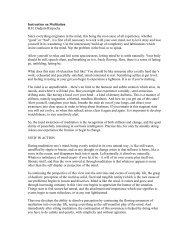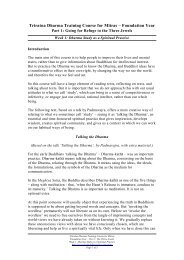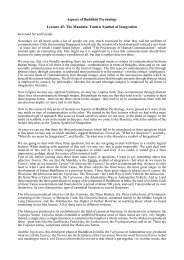Triratna's Distinctive Emphases - Free Buddhist Audio
Triratna's Distinctive Emphases - Free Buddhist Audio
Triratna's Distinctive Emphases - Free Buddhist Audio
Create successful ePaper yourself
Turn your PDF publications into a flip-book with our unique Google optimized e-Paper software.
Triratna Dharma Training Course for Mitras – Foundation Year<br />
Part 5: Buddhism and the Triratna <strong>Buddhist</strong> Community, Devotional<br />
Practice<br />
Text purpose written by Vadanya<br />
The common ground<br />
Week 3: The <strong>Distinctive</strong> <strong>Emphases</strong> of Triratna<br />
The Triratna <strong>Buddhist</strong> Community is radical, in that it seeks to get back to what is<br />
universal in the <strong>Buddhist</strong> tradition: that which can jump the centuries, cross<br />
cultures, and speak directly to us here and now. But Triratna is still a recognisably<br />
<strong>Buddhist</strong> movement, and it shares a lot of common ground with other <strong>Buddhist</strong><br />
schools. This is not surprising, as it bases its approach on the core teachings and<br />
practices that are the basis for all schools.<br />
Nevertheless Triratna is a creative response to present-day Western conditions.<br />
These are very different from those in 500 BCE India, First Millennium China, or<br />
medieval Tibet and Japan. So, not surprisingly, there are some things about<br />
Triratna that are quite distinctive.<br />
An ‘ecumenical’ approach<br />
The first distinctive feature of Triratna is that we have an „ecumenical‟ approach.<br />
The word „ecumenical‟ is derived from the Christian tradition, where it means<br />
transcending the differences between different sects or churches. As we saw in the<br />
last session, the underlying unity of Buddhism is an important principle behind<br />
Triratna. We do not identify exclusively with any sect or tradition, or with any<br />
cultural manifestation of Buddhism. So we do not equate Buddhism with any one<br />
of its historical schools, or with any one of the various national cultures in which<br />
the Eastern schools are embodied. Instead we seek to see what the various schools<br />
have in common, looking for the general truths behind the particular cultural<br />
forms of Buddhism, at the same time as drawing inspiration and practices from the<br />
whole <strong>Buddhist</strong> tradition.<br />
In the centuries and millennia after the Buddha‟s death, Buddhism took its<br />
message outwards from India into a wide range of new cultures and circumstances.<br />
Spread over a vast area, in an age when travel was slow and dangerous, and other<br />
forms of communication over long distances were non-existent, a number of<br />
different schools developed which were largely isolated from each other. Members<br />
of these schools often had little knowledge of each other, and they had no<br />
historical overview of the <strong>Buddhist</strong> tradition. They therefore each tended to see<br />
themselves as the true representative of the <strong>Buddhist</strong> tradition at its best.<br />
But now for the first time in history all the <strong>Buddhist</strong> schools can be aware of each<br />
other, and we can see the historical process through which each developed. It is no<br />
longer possible to regard any one sect as „real‟ Buddhism, except by ignoring the<br />
facts. However this is what many traditional schools still try to do, even when<br />
Triratna Dharma Training Course for Mitras<br />
Foundation Year, Part 5: Buddhism and the Triratna <strong>Buddhist</strong> Community, Devotional Practice<br />
Week 3: The <strong>Distinctive</strong> <strong>Emphases</strong> of the Triratna <strong>Buddhist</strong> Community<br />
http://www.freebuddhistaudio.com/study<br />
Page 1 of 8
transplanted to the West. It is still quite normal for such transplanted schools in<br />
their public classes to put forward their particular teachings as „Buddhism‟,<br />
making no mention of the teachings or practices of any other tradition.<br />
For Buddhism to take root in the West it has to outgrow this culturally based<br />
sectarianism. We need to look at the different schools, see what they have in<br />
common, appreciate them, gain inspiration from them, and learn from them. We<br />
need to get back to the basic truths of Buddhism that underlie all schools, and use<br />
what is useful under present circumstances from the whole range of the tradition.<br />
And we need to do this without simply taking a magpie approach, picking up the<br />
glittery parts of the various schools that attract our eye, while ignoring the<br />
apparently duller or more challenging teachings and practices that may be what we<br />
really need to transform ourselves. All this is what Triratna is trying to do,<br />
although we are still at an early stage.<br />
This might seem obvious. We tend to take this appreciation of the whole tradition<br />
for granted in Triratna, but it is a very unusual approach. Yet this is probably the<br />
only approach that will allow Buddhism to have the full impact on the modern<br />
world that it deserves – and that the modern world so badly needs. (Incidentally,<br />
all this is not to say that modern Westerners cannot make spiritual progress<br />
through one of the traditional schools.)<br />
The centrality of Going for Refuge<br />
A second distinctive emphasis of Triratna is that we see Going for Refuge as<br />
primary in the spiritual life, and particular lifestyles or practices as secondary. We<br />
could paraphrase this by saying that what is most important is our commitment to<br />
spiritual growth, while the way we put this commitment into practice may vary<br />
from person to person and time to time.<br />
What is important is our commitment to the Three Jewels. Firstly this means<br />
commitment to becoming more like the Buddha, the ideal of Enlightenment.<br />
Secondly it means commitment to understanding and practising the Dharma.<br />
Thirdly it means coming into greater and greater harmony and communication<br />
with our fellow practitioners, so that between us we create the Sangha. The level<br />
and constancy of this commitment is what will mainly determine whether we make<br />
progress. Without this commitment, the most favourable lifestyle and the most<br />
supposedly „advanced‟ practices will be useless. With this commitment, we will<br />
use difficulties as opportunities to grow, and the simplest practices will reveal<br />
depths that are unimaginable to the uncommitted.<br />
In contrast to Triratna‟s approach, many traditional schools see a particular<br />
lifestyle or practice as central to being a „real‟ <strong>Buddhist</strong>. So in some schools what<br />
makes someone a „real‟ <strong>Buddhist</strong> is living the monastic life. In other schools it is a<br />
particular practice or set of practices – „Just Sitting‟ meditation in Zen, a particular<br />
chant in Nichiren and „True Pure Land‟ Buddhism, or a particular sequence of<br />
meditations leading up to tantric initiation in some Tibetan schools. But in fact<br />
Triratna Dharma Training Course for Mitras<br />
Foundation Year, Part 5: Buddhism and the Triratna <strong>Buddhist</strong> Community, Devotional Practice<br />
Week 3: The <strong>Distinctive</strong> <strong>Emphases</strong> of the Triratna <strong>Buddhist</strong> Community<br />
http://www.freebuddhistaudio.com/study<br />
Page 2 of 8
particular lifestyles or practices are all means to an end. They are not central to<br />
being a „real‟ <strong>Buddhist</strong>. What is central is Going for Refuge.<br />
Because Going for Refuge is primary, while lifestyle is secondary, the Triratna<br />
<strong>Buddhist</strong> Order is „neither monk nor lay.‟ Some Order members live what is<br />
effectively a monastic life. Some live a „lay‟ life, bringing up a family and earning<br />
the money needed to do this. Many combine elements of both lifestyles, perhaps<br />
living in a semi-monastic community without being celibate, or alternating periods<br />
of meditative monastic living „on retreat‟ with periods of activity „in the world‟.<br />
After all, the strict division between monk and lay was a product of traditional<br />
societies where no other possibility was allowed, and in the modern world we can<br />
be less rigid. What unites members of the Order is not a lifestyle, but the fact that<br />
they have all been recognised as „effectively‟ Going for Refuge, which means that<br />
their commitment has been seen to be powerful enough, consistent enough, and<br />
central enough in their lives to have a noticeable effect over a significant period of<br />
time.<br />
Because Going for Refuge is primary, members of the Triratna <strong>Buddhist</strong> Order –<br />
and to a lesser extent friends and mitras – will engage in a range of practices<br />
suited to their temperament and circumstances. In the earlier stages of practice<br />
what is important is to lay a firm foundation. So in our first few years of practice<br />
most of us need to focus mainly on the Five Precepts, the Mindfulness of<br />
Breathing, and the Mettā Bhāvanā. However even in the earlier stages, Triratna<br />
encompasses a range of approaches, with people emphasising different aspects of<br />
practice, and drawing inspiration from different sources. When we have been<br />
practising for longer, Going for Refuge can manifest in even more diverse ways.<br />
In consultation with their Preceptors, new Order members take on a range of<br />
meditations, and develop their own regime of practice, suited to their temperament<br />
and circumstances. Again, the Triratna <strong>Buddhist</strong> Order can happily include this<br />
range of diversity, because Going for Refuge is primary, while the particular<br />
practices we take up to express and deepen our Going for Refuge may vary<br />
according to needs and circumstances.<br />
Finally, one manifestation of the centrality of Going for Refuge in Triratna is that<br />
the people who lead and guide the movement‟s institutions are those who have<br />
shown themselves to be effectively going for refuge over a significant period of<br />
time – in other words, members of the Triratna <strong>Buddhist</strong> Order. Before he founded<br />
the FWBO, Sangharakshita observed that many modern <strong>Buddhist</strong> organisations<br />
were controlled by people who were not committed <strong>Buddhist</strong>s. This is obviously<br />
not the way to set up an effective, liberating spiritual movement, and he was<br />
determined that Triratna should be run by the spiritually committed. In effect this<br />
means that the various Triratna charities that manage centres and other Triratna<br />
initiatives are run mainly by Order members – those people who have been<br />
recognised as effectively going for refuge. This is still viewed as an important<br />
principle of Triratna, which is partly responsible for its success. However, it can<br />
seem odd to some people – who want to apply egalitarian principles, derived from<br />
politics, to the spiritual life – that the important decisions at a centre are usually<br />
made by Order members, and not by a vote among the people who attend.<br />
Triratna Dharma Training Course for Mitras<br />
Foundation Year, Part 5: Buddhism and the Triratna <strong>Buddhist</strong> Community, Devotional Practice<br />
Week 3: The <strong>Distinctive</strong> <strong>Emphases</strong> of the Triratna <strong>Buddhist</strong> Community<br />
http://www.freebuddhistaudio.com/study<br />
Page 3 of 8
The importance of friendship<br />
An emphasis on „horizontal‟ friendship is a possibly unique aspect of Triratna.<br />
Many schools encourage devotion to the teacher, master, or guru, but few<br />
emphasise friendship between people who are at a similar stage of the path –<br />
„horizontal‟ friendships – possibly because warm close friendships were taken for<br />
granted in traditional societies. However in Triratna friendship is seen as an<br />
important part to the spiritual life in two ways: firstly as a way of overcoming our<br />
self-obsession and deluded view, and secondly as an aspect of the goal of<br />
Enlightenment itself.<br />
The Buddha said on a number of occasions that spiritual friendship is an essential<br />
part of the spiritual life. Because it is an aspect that many Westerners do not find<br />
easy, and one that our culture makes difficult – by encouraging individualism,<br />
competitiveness, and mobility – it is an aspect that we particularly need to<br />
emphasise.<br />
Developing friendship is part of the way we grow. We transcend our egotism and<br />
break out of the box of our self-concern by deep and open communication, by<br />
developing empathy, by becoming more concerned for others, and by developing<br />
qualities such as loyalty and gratitude. We need friendship to develop mettā,<br />
compassion, and sympathetic joy – ultimately we aim to experience these for all<br />
other beings, but we need to start with our friends, who are not linked to us by ties<br />
of blood or self-interest, but for whom we feel warm affection.<br />
Spiritual friends also help us to see ourselves more clearly – an essential part of<br />
growth. We all have aspects of ourselves that we hide from others – which makes<br />
it very difficult to work on them. Learning to be open and honest with others,<br />
taking off our mask, helps us to leave these hidden aspects behind, and move on.<br />
We all also have „blind spots‟ – aspects of ourselves that we do not know about,<br />
which we hide even from ourselves. Spiritual friends – who take our spiritual wellbeing<br />
to heart, rather than colluding with us for an easy life – will help us to see<br />
these blind spots. Unless we are open to seeing ourselves as others see us we will<br />
probably never move forward, because we will not know ourselves as we really<br />
are.<br />
This last point also brings out the fact that Spiritual growth requires an element of<br />
„vertical‟ friendship – contact with those who are more experienced in the spiritual<br />
life than we are. In most traditional schools this relationship is formalised in a<br />
strict teacher-pupil or guru-disciple relationship. However Sangharakshita has<br />
pointed out that the guru-disciple relationship has many dangers, especially for<br />
Westerners, and that we do not usually need a „great guru‟ – even if we could find<br />
one who would accept us. What we do need is contact with people who are more<br />
strongly in touch with a spiritual vision than we are, and who have more<br />
experience of the spiritual path than we do. It has been said that “the spiritual life<br />
is caught, not taught.” So having contact with people who have been practising<br />
longer than we have is an important part of our practice in Triratna.<br />
Triratna Dharma Training Course for Mitras<br />
Foundation Year, Part 5: Buddhism and the Triratna <strong>Buddhist</strong> Community, Devotional Practice<br />
Week 3: The <strong>Distinctive</strong> <strong>Emphases</strong> of the Triratna <strong>Buddhist</strong> Community<br />
http://www.freebuddhistaudio.com/study<br />
Page 4 of 8
So far we have talked about friendship as a means to an end. But friendship is also<br />
an end in itself. Friendship is an essential part of a happy, human life – and one of<br />
which many people are starved in the modern West. At a higher level, friendship<br />
can be seen as an important aspect of the spiritual goal. Enlightenment is a state in<br />
which we transcend our small, self-referential frame of reference and become a<br />
friend of the world. In effect we take our mundane human friendliness and raise it<br />
to new level, so that we are united in friendliness to all other people, to all other<br />
beings, and to the universe itself. We cannot hope to achieve this universal<br />
friendliness unless we start by behaving as a friend to at least a few real people.<br />
Because of the emphasis on friendship, many Triratna <strong>Buddhist</strong>s choose to live in<br />
residential communities. To really get to know people and develop deep<br />
friendships we need to spend time with them, and not just when we are on our best<br />
behaviour. Not everyone is in a position to live in a community, but for those that<br />
are, it can be an important help to spiritual practice, letting us immerse ourselves<br />
more deeply in the spiritual life, eroding our individualism and self obsession,<br />
allowing us to see ourselves more clearly, and – last but not least – helping us<br />
develop deeper friendships.<br />
The importance of work<br />
The Triratna <strong>Buddhist</strong> Community offers a balanced approach to the spiritual life.<br />
An important part of this balance is the need to balance meditation, on the one<br />
hand, with energy and activity on the other. Energy is one of the characteristics of<br />
Enlightenment. But there can be a tendency to associate the spiritual life with<br />
being simply calm, inactive, and delicate. If we give a one-sided emphasis to calm<br />
inactivity we will tend to repress our energy, which will become stagnant or turn<br />
negative. This can be a problem in some traditional Eastern monastic settings. To<br />
quote Sangharakshita:<br />
„…work is very important, because if you‟re working…you‟re putting<br />
energy into something, with the result that energy does not stagnate. If<br />
there is any sort of curse of monasticism in the East, and it‟s a real curse,<br />
it‟s simply stagnation and idleness.‟<br />
The major exception to this comment is the Zen tradition, in which daily physical<br />
work is an integral part of monastery life.<br />
Triratna‟s emphasis on work can sound odd to some Westerners, because for many<br />
of us „worldly‟ careers, which we follow mainly for money and status, can make it<br />
difficult to find time and energy for spiritual practice. Hence many <strong>Buddhist</strong>s find<br />
it helpful to reduce the time they spend working, and to take periods off work<br />
when they can explore different aspects of their being. Such periods of „idleness‟<br />
are probably essential for most of us, and they may be particularly important if our<br />
life so far has been dominated by work or career. But the problem arises when we<br />
see idleness as a long term lifestyle – we have energy, and we need to use it to<br />
have a positive effect on the world, both for our own sake and for the sake of<br />
others.<br />
Triratna Dharma Training Course for Mitras<br />
Foundation Year, Part 5: Buddhism and the Triratna <strong>Buddhist</strong> Community, Devotional Practice<br />
Week 3: The <strong>Distinctive</strong> <strong>Emphases</strong> of the Triratna <strong>Buddhist</strong> Community<br />
http://www.freebuddhistaudio.com/study<br />
Page 5 of 8
The usefulness of work as part of our spiritual life depends on our motivation. If<br />
we are working just to earn a living, then it is probably a good idea to do as little<br />
of it as possible, and to simplify our life accordingly. However we will then need<br />
to find other more useful ways of using our energy. The type of work that<br />
Sangharakshita recommends as part of our spiritual life is work that has an<br />
altruistic or spiritual motivation, because it is helping to spread the Dharma,<br />
because it helps us to work on ourselves, because it helps us develop spiritual<br />
friendship, or because it helps other people.<br />
‘Team-based Right Livelihood businesses’<br />
One very distinctive feature of Triratna are our team-based businesses. Apart from<br />
enabling people to earn a living in an ethical way, in an environment conducive to<br />
spiritual practice, these projects aim to help <strong>Buddhist</strong>s to activate and engage their<br />
energies, and to provide a context in which we can use work as a direct spiritual<br />
practice.<br />
Sangharakshita‟s has said that „Work is the Tantric guru.‟ In the Tantric tradition,<br />
one of the guru‟s roles is to confront the disciple with their own shortcomings, and<br />
with the true nature of things. In the same way, work confronts us with ourselves,<br />
and, if we are honest, it forces us to change. Work provides us with an objective<br />
way of looking at ourselves. If the outcome of our work is ineffective, or if we are<br />
out of harmony with our team-mates, then we are made to look at those aspects of<br />
ourselves that contribute to the situation, and which we need to change. So work in<br />
a team-based business can be a challenging and powerful spiritual practice, which<br />
allows us to grow and change far faster than would be possible in a less intense<br />
situation.<br />
Work for others<br />
When our work helps other people – especially when it helps them spiritually – it<br />
becomes fully aligned with our spiritual ideals, and we can throw ourselves into it<br />
wholeheartedly. If we are building a <strong>Buddhist</strong> Centre, raising money to spread the<br />
Dharma, or publishing Dharma books, we will experience our work not just as a<br />
job, but as a vocation. Work that genuinely relieves people‟s suffering – either<br />
psychological or physical – will have a similar effect. For this reason Triratna has<br />
set up a charity, the Karuna Trust, to help <strong>Buddhist</strong>s in the prosperous West use<br />
their energies to work for others less physically fortunate. Working for others is<br />
deeply satisfying, and has far-reaching spiritual consequences. To the extent that<br />
our work is truly about others, to that extent we transcend ourselves, breaking<br />
down our rigid self identification – which is the whole purpose of the spiritual life.<br />
When work for others is part of a balanced practice, including spiritual<br />
community, meditation, and devotion to a spiritual cause, it can be a powerful<br />
ingredient in gaining Insight.<br />
The importance of the Arts<br />
Triratna Dharma Training Course for Mitras<br />
Foundation Year, Part 5: Buddhism and the Triratna <strong>Buddhist</strong> Community, Devotional Practice<br />
Week 3: The <strong>Distinctive</strong> <strong>Emphases</strong> of the Triratna <strong>Buddhist</strong> Community<br />
http://www.freebuddhistaudio.com/study<br />
Page 6 of 8
Unlike most Eastern cultures (except China) when they first encountered<br />
Buddhism, the West has a very well developed cultural and artistic tradition. At its<br />
best this tradition communicates spiritual values and a spiritual vision, and<br />
because it is culturally closer to us than Eastern forms of the Dharma, it can be a<br />
valuable bridge to a more spiritual view of life. Also, because many of us live in<br />
cities which are a far cry from the beautiful natural settings in which many<br />
<strong>Buddhist</strong>s of the past have practised, we need ways of contacting the sense of<br />
beauty and wonder that we can get from living in nature. Contact with the arts can<br />
give us this, as well as helping us to grow spiritually in some of the following ways.<br />
Art helps us expand our experience and broader our sympathies<br />
The Arts can allow us to live through experiences that have never happened to us<br />
in „real‟ life, letting us grow through them and learn from them almost as though<br />
they had been our own. Through a play, novel or poem we can enter into the world,<br />
the thoughts, and the feelings of another person. We can know what it is like to be<br />
them, and we can develop a sense of sympathy for them. Visual art can have the<br />
same effect – really looking at Rembrandt‟s self-portraits, for example, lets us<br />
experience what it felt like to be that man at various points in a life that was both<br />
tragic and fulfilling. In the same way, music can directly communicate what it is<br />
like to feel as another human being feels. Art can allow us to know what it is like<br />
to be another person, of a very different age, nation, race, culture, gender, and<br />
temperament. This broadening of our experience and our ability to identify with<br />
others is a very real expansion of our being. It is spiritual growth.<br />
Art enlarges our imagination<br />
Our separation from nature and the emphasis on mundane facts in our culture can<br />
atrophy our imagination. We need to counteract this, because imagination is an<br />
important faculty in the spiritual life. It allows us to contact possible ways of<br />
being that are completely beyond us at present. Imagination also opens a gateway<br />
to the visionary world we can experience in meditation – if our imagination is<br />
impoverished, our meditation is likely be so too. Engaging in art, whether in<br />
creating it or appreciating it, strengthens the imagination, just as we strengthen a<br />
muscle by taking physical exercise.<br />
Art refines and redirects our emotions<br />
Usually our emotions are tied to a fairly coarse, basic level of existence. What<br />
excites them most usually has to do with things like sex, physical pleasure, money,<br />
possessions, security, and self-importance – things that derive from our animal<br />
nature. Our emotions are what drive us, and as long as most of our emotional<br />
energy is stuck at this level, we will have little real drive for spiritual progress. We<br />
therefore need to progressively refine and raise the level of our emotions, so that<br />
more and more we get our satisfaction from the spiritual plane, and so that our<br />
emotions are linked to this plane. Art, and any experience of beauty, tends to<br />
refine our emotions. When we delight in the beauty of a piece of music, a painting,<br />
a building, or a tree, our emotions are engaged in a way that is not related to our<br />
Triratna Dharma Training Course for Mitras<br />
Foundation Year, Part 5: Buddhism and the Triratna <strong>Buddhist</strong> Community, Devotional Practice<br />
Week 3: The <strong>Distinctive</strong> <strong>Emphases</strong> of the Triratna <strong>Buddhist</strong> Community<br />
http://www.freebuddhistaudio.com/study<br />
Page 7 of 8
animal ego. When we appreciate a sonnet or a sunset, this does not involve<br />
wanting to own it, eat it, or have sex with it. The more we hook our emotions to<br />
this sort of aesthetic appreciation, the more emotional energy we will be able to<br />
muster behind our meditation practice, and the more we can move our motivations<br />
up to the level of the spiritual and the transcendental.<br />
Art can communicate spiritual values<br />
The greatest art comes from the realm that the Dharma comes from – the creators<br />
of great art often speak of something communicating itself through them,<br />
something that transcends anything they are normally in touch with in their more<br />
mundane, non-creative times. Indeed the greatest art is Dharma, in its broadest<br />
definition. It derives from a spiritual vision and communicates spiritual values. It<br />
often does this in a way that is not linked specifically to any one „religious‟<br />
formulation of the Dharma, although it may be strongly flavoured by a particular<br />
religion, if the artist practised it. Great art is the Dharma communicated in a very<br />
attractive way, a way that makes us want to change ourselves. Truth<br />
communicated in a beautiful way is uniquely powerful.<br />
Questions for reflection and discussion<br />
1. Have any of the „distinctive emphases‟ described in the text been important<br />
in your decision to practice with Triratna rather than with a traditional<br />
Asian school? Are there any of the „emphases‟ that you don‟t relate to?<br />
2. What might be the advantages and disadvantages of an „ecumenical‟<br />
approach to Buddhism? How can we guard against any dangers it might<br />
involve?<br />
3. The Triratna <strong>Buddhist</strong> Community‟s emphasis on Going for Refuge seems<br />
to give priority to commitment as a spiritual quality. How do you think<br />
commitment is related to other aspects of spiritual progress, such as<br />
simplicity of life, śraddhā, insight, and concern for others? How might<br />
commitment lead to each of these, and how might each of these lead to<br />
commitment?<br />
4. Has the quality of your friendships changed since getting involved in<br />
Triratna? In what ways?<br />
5. Do you tend to see calm or energy as more important in the spiritual life?<br />
What are the advantages and dangers of both points of view?<br />
6. Do you think you need to do more work, or less? Would the answer be<br />
different if you did a different sort of work? Have you ever experienced<br />
work as „the Tantric Guru?‟<br />
7. What is the difference between art that can help us to develop spiritually,<br />
and mere entertainment that we use to distract ourselves?<br />
Triratna Dharma Training Course for Mitras<br />
Foundation Year, Part 5: Buddhism and the Triratna <strong>Buddhist</strong> Community, Devotional Practice<br />
Week 3: The <strong>Distinctive</strong> <strong>Emphases</strong> of the Triratna <strong>Buddhist</strong> Community<br />
http://www.freebuddhistaudio.com/study<br />
Page 8 of 8


